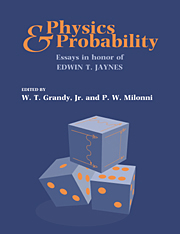Book contents
- Frontmatter
- Contents
- Preface
- Recollections of an Independent Thinker
- A Look Back: Early Applications of Maximum Entropy Estimation to Quantum Statistical Mechanics
- The Jaynes–Cummings Revival
- The Jaynes–Cummings Model and the One-Atom-Maser
- The Jaynes–Cummings Model is Alive and Well
- Self-Consistent Radiation Reaction in Quantum Optics – Jaynes' Influence and a New Example in Cavity QED
- Enhancing the Index of Refraction in a Nonabsorbing Medium: Phaseonium Versus a Mixture of Two-Level Atoms
- Ed Jaynes' Steak Dinner Problem II
- Source Theory of Vacuum Field Effects
- The Natural Line Shape
- An Operational Approach to Schrödinger's Cat
- The Classical Limit of an Atom
- Mutual Radiation Reaction in Spontaneous Emission
- A Model of Neutron Star Dynamics
- The Kinematic Origin of Complex Wave Functions
- On Radar Target Identification
- On the Difference in Means
- Bayesian Analysis, Model Selection and Prediction
- Bayesian Numerical Analysis
- Quantum Statistical Inference
- Application of the Maximum Entropy Principle to Nonlinear Systems Far from Equilibrium
- Nonequilibrium Statistical Mechanics
- A Backward Look to the Future
- Appendix: Vita and Bibliography of Edwin T. Jaynes
- Index
Mutual Radiation Reaction in Spontaneous Emission
Published online by Cambridge University Press: 21 October 2009
- Frontmatter
- Contents
- Preface
- Recollections of an Independent Thinker
- A Look Back: Early Applications of Maximum Entropy Estimation to Quantum Statistical Mechanics
- The Jaynes–Cummings Revival
- The Jaynes–Cummings Model and the One-Atom-Maser
- The Jaynes–Cummings Model is Alive and Well
- Self-Consistent Radiation Reaction in Quantum Optics – Jaynes' Influence and a New Example in Cavity QED
- Enhancing the Index of Refraction in a Nonabsorbing Medium: Phaseonium Versus a Mixture of Two-Level Atoms
- Ed Jaynes' Steak Dinner Problem II
- Source Theory of Vacuum Field Effects
- The Natural Line Shape
- An Operational Approach to Schrödinger's Cat
- The Classical Limit of an Atom
- Mutual Radiation Reaction in Spontaneous Emission
- A Model of Neutron Star Dynamics
- The Kinematic Origin of Complex Wave Functions
- On Radar Target Identification
- On the Difference in Means
- Bayesian Analysis, Model Selection and Prediction
- Bayesian Numerical Analysis
- Quantum Statistical Inference
- Application of the Maximum Entropy Principle to Nonlinear Systems Far from Equilibrium
- Nonequilibrium Statistical Mechanics
- A Backward Look to the Future
- Appendix: Vita and Bibliography of Edwin T. Jaynes
- Index
Summary
ABSTRACT. Each transition dipole in a single atom has a radiation reaction field which acts on itself and on the other transition dipoles of the atom. The self interaction on a given transition gives rise to spontaneous emission and radiative decay on that transition. Here we emphasize that the mutual radiative interaction of different transition dipoles can sometimes have important consequences. The mutual radiative interaction can substantially alter radiative decay rates and inhibit the radiative decay of certain expectation values. The hydrogen atom and the harmonic oscillator are cited as examples and a possible experimental test of mutual radiation reaction involving a single electron in a Penning trap is discussed.
Introduction
Modern quantum mechanics began with Heisenberg's picture of a bound charge as a “virtual orchestra” of transition dipoles oscillating at different frequencies. It is known from modern quantum theory that each of these dipoles generates a radiation reaction field which, acting on the dipole itself, gives rise to spontaneous emission and radiative relaxation (Milonni, 1976). In this paper we consider the mutual interaction of different transition dipoles within a single “atom”. We begin by considering some simple cases of mutual radiation reaction in classical electrodynamics and proceed to the quantum theory of mutual radiation reaction (MRR), citing the hydrogen atom and the charged harmonic oscillator as examples. We point out that the equations describing MRR are not at all new, but can be traced to the earliest treatments of the interaction of atoms with the quantized electromagnetic field.
- Type
- Chapter
- Information
- Physics and ProbabilityEssays in Honor of Edwin T. Jaynes, pp. 127 - 136Publisher: Cambridge University PressPrint publication year: 1993



